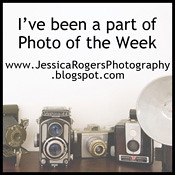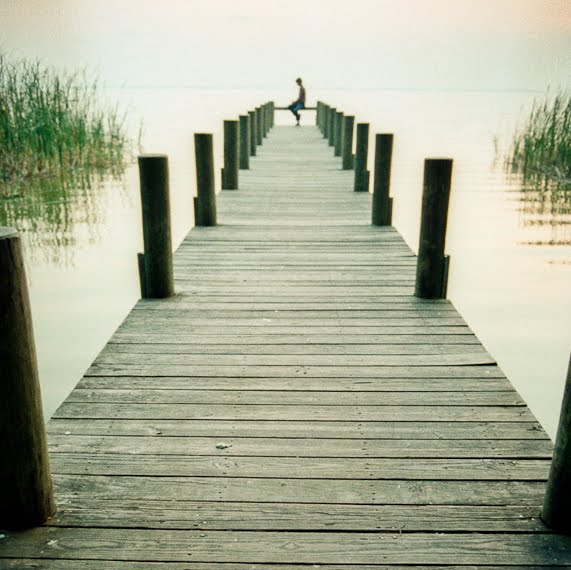 My first memory of any camera was my oldest sister's 110. I am sure it was a Kodak of some sort, but the 110. I think this holds the first memory, as I was full of envy. Not knowing then that I would be surrounded by cameras for the rest of my life.
My first memory of any camera was my oldest sister's 110. I am sure it was a Kodak of some sort, but the 110. I think this holds the first memory, as I was full of envy. Not knowing then that I would be surrounded by cameras for the rest of my life.
The next one in a long line was the infamous Disc camera, again by Kodak, and again my sister's. I see these for sale on Etsy and eBay as collectors, which I find beyond amusing since the negative was about as big as a dime. Horrid little thing, but it was portable and very discreet for its day.
 Now, the fun gets started: Polaroids. If you did not have the luxury of growing up with a Polaroid, or have one at any point in your life, you really missed out. My other sister had the One Step, just like this one. She let me use it, when we had film. But, ugh, the film was so expensive; the one major flaw in this camera.
Now, the fun gets started: Polaroids. If you did not have the luxury of growing up with a Polaroid, or have one at any point in your life, you really missed out. My other sister had the One Step, just like this one. She let me use it, when we had film. But, ugh, the film was so expensive; the one major flaw in this camera.  Now, I will get you into my cameras. I am sure my parents waited until I was old enough not to ruin a camera. But here's to the first which came to me in 8th grade: my Ricoh.
Now, I will get you into my cameras. I am sure my parents waited until I was old enough not to ruin a camera. But here's to the first which came to me in 8th grade: my Ricoh. It's hard to believe this plastic camera survived the years until I went to Penn State for my second year of college, when my dad gave me his Canon AE-1 with a variety of lenses. The AE-1 was my first real camera and some of the images I shot are still some of my favorites. Crisp, sharp, good color... and I had full control over everything. It really let me find my eyes (so to speak) as a photographer.
It's hard to believe this plastic camera survived the years until I went to Penn State for my second year of college, when my dad gave me his Canon AE-1 with a variety of lenses. The AE-1 was my first real camera and some of the images I shot are still some of my favorites. Crisp, sharp, good color... and I had full control over everything. It really let me find my eyes (so to speak) as a photographer. This camera was heavy. I mean a beast. But I still shot with it everywhere. I took it to Europe, shot a Fashion Runway shoot in Orlando with it, which was tricky shooting 100-300mm manual focus zoom handheld.
When I lived in central Florida, I worked at Wolf Camera and I started to collect old cameras. My grandfather's old Kodaks were my first forray into any film other than 35mm. They took 120. At the time I thought that was a vintage film, like 110. The cameras took these gloriously grainy images and I had to look down through this view finder. It was weird for me, but cool, too.
Anything vintage. But I fell in love with rangefinders. And the camera that started it all was a gorgeous 1969 Minolta Hi-Matic 11 Super 3 Circuit I bought at Terry & Jerry's in Lakeland. I had no idea what a rangefinder was, but that camera took the most gorgeous of black & whites. I knew how to line up the dual images, since that how you focused with the AE-1. The Hi-Matic was my go to camera for years, if I shot anything black and white.
 My sister and I moved out to Oregon in the later part of the 90s and the AE-1 documented the whole journey and time there... until I started working at Pro Photo Supply. Probably the one move that changed everything for me. I decided it was time to get a new 35mm point n shoot and knew I found THE one with the Yashica T4. Oh! a Zeiss lens. I had learned that this glass was the best optical glass ever and I needed this camera. I bought one. My sister also bought one, which she still uses today.
My sister and I moved out to Oregon in the later part of the 90s and the AE-1 documented the whole journey and time there... until I started working at Pro Photo Supply. Probably the one move that changed everything for me. I decided it was time to get a new 35mm point n shoot and knew I found THE one with the Yashica T4. Oh! a Zeiss lens. I had learned that this glass was the best optical glass ever and I needed this camera. I bought one. My sister also bought one, which she still uses today. Pro Photo Supply enabled me to learn about other camera companies and their systems and I fell in love with the idea of a Nikon SLR. By replacing my Canon gear with this, I could buy a manual focus system, piece by piece until I could later afford an AF system. But the MF system I fell in love with was the Nikon F3HP. Another tank-of-a-camera, but I adored this camera. It also made me feel like I was moving into the pro arena of photography.
The clientele at PPS were all pro's and some budding amateurs, some of whom went to Brooks Institute and knew SO much more than I. I wanted to hook their brain up to a shop vac and dump their knowledge into my brain. To a certain degree, I did. And here came the Hassleblad with Zeiss glass lenses. My first ever experience with a medium format camera of the 20th century. Again, another beast to carry, but I didn't even care. I was in love. The pictures were so amazing compared to 35mm. Thank god I could rent from PPS.
 I was surrounded by so many people who actually knew how to take great photos with whatever camera they used, be it Leica, Rolleiflex, 4x5, even Holga's. Ah, the Holga. This was the only way I could own a medium format camera since it was $25, oh and $5 for the roll of gaffer's tape you needed to seal up the light leaks. But the look was so vintage!
I was surrounded by so many people who actually knew how to take great photos with whatever camera they used, be it Leica, Rolleiflex, 4x5, even Holga's. Ah, the Holga. This was the only way I could own a medium format camera since it was $25, oh and $5 for the roll of gaffer's tape you needed to seal up the light leaks. But the look was so vintage! After working there for a number of years, I had the extreme fortune to be sent, along with a co-worker and great friend of mine to see the Profoto Lighting factory in Stockolm, Sweden. Profoto was distributed stateside by Mamiya Corp. And the fantastic Mamiya sales rep offered to let me borrow and check out the Mamiya 7 II, a medium format rangefinder. YUM! I loved this camera. The portability of a 35mm, but with the gorgeous images from a medium format. Ugh! I was in heaven.
After working there for a number of years, I had the extreme fortune to be sent, along with a co-worker and great friend of mine to see the Profoto Lighting factory in Stockolm, Sweden. Profoto was distributed stateside by Mamiya Corp. And the fantastic Mamiya sales rep offered to let me borrow and check out the Mamiya 7 II, a medium format rangefinder. YUM! I loved this camera. The portability of a 35mm, but with the gorgeous images from a medium format. Ugh! I was in heaven.The best of all worlds combined. I would still love to have this camera, but with digital now in the mix and labs dropping off of the map left and right, how does that compare??? Fast forward several years... When we moved here to North Carolina and we bought our so loved and well used kayaks, I knew I needed something small and digital that I could take on the water. And this trusty little guy has survived a lot and still takes good shots: the Powershot.
I even used this for our first product shots for brandMOJO Interiors back before we had our own website. But now, it all comes full circle. I was ready to get my first AF digital Nikon SLR since I had acquired mf lenses over the years for my older F3HP manual focus body. Remember how I said I bought it knowing I could then move up slowly until I could get the autofocus system. Well, 12 years later, I was ready.
Up until a few months ago, I didn't even own an autofocus lens. I used those glorious mf Nikon lenses with this great lightweight camera body. And actually, I still shoot product with those lenses.
So, the 110, Disc, and One Step are collectibles now. You can buy a Holga still in 35mm format now for the plastic camera experience that is still holding strong. Just don't forget the gaffer's tape. And rangefinders and film cameras are the new thing with twenty-somethings, who've never experienced film.
They say that it isn't the gear you use that dictates whether you are a good photographer or not, which I do agree with. But it is a lot of fun using a variety of different pieces of equipment from many time periods in history and learning photography on them. And fun looking back.
Click click


















